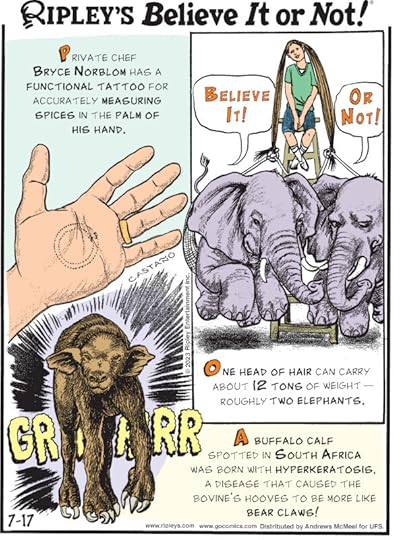Ripley Entertainment Inc.'s Blog, page 17
July 18, 2023
CARTOON 07-18-2023
July 17, 2023
CARTOON 07-17-2023
July 16, 2023
CARTOON 07-16-2023
July 15, 2023
CARTOON 07-15-2023
July 14, 2023
Ripley’s Round Trip: The World’s Most Mysterious Islands
Featured in Ripley's Believe It or Not!

Welcome to a spine-tingling episode of Ripley’s Round Trip, where we’ll explore the world’s most mysterious islands, uncovering their dark histories and creepy secrets, and get ready for an unforgettable journey into the unknown as we set sail to uncover the truth behind these fascinating islands.
An Island of… Criminals?The notorious Alcatraz Island is a former maximum-security prison in the heart of San Francisco Bay. From 1934 to 1963, this imposing fortress housed some of America’s most dangerous criminals, including the likes of Al Capone and George “Machine Gun” Kelly. Known for its brutal conditions and dramatic escape attempts, Alcatraz has become a symbol of intrigue and mystery. Before its days as a prison, Alcatraz also served as a military fort and later a military prison during the Spanish-American War, adding even more layers of history to this island.
Straight Out of a NightmareWhat didn’t start out as a tourist destination has now become a hot spot for adventure travelers everywhere. Mexico’s Island of the Dolls, is a haunting location adorned with hundreds of decaying dolls hanging from trees. These eerie figures were placed there by the island’s caretaker, Julian Santana Barrera, in an attempt to appease the spirit of a young girl who tragically drowned nearby. Legend has it that Julian himself experienced inexplicable events and claimed to hear whispers in the night, which led him to spend over 50 years collecting and placing the dolls around the island. Some witnesses claim they had heard the dolls whispering to each other, while others who were on a boat near the island said the dolls lured them to come down to the island.

The Bikini Atoll in the Pacific Ocean is the site where 23 nuclear tests were conducted by the United States between 1946 and 1958. The local population was forcibly relocated, and the atoll was subjected to devastating nuclear explosions, including the infamous “Castle Bravo” test which resulted in widespread radioactive fallout, affecting nearby inhabited islands and even leading to the contamination of a Japanese fishing boat, causing international outrage and raising awareness of the dangers of nuclear testing.
An Island Filled with GravesLet’s set our sights on New York City’s Hart Island, a somber potter’s field that has served as the final resting place for over a million unclaimed bodies since the 19th century. Managed by the Department of Correction, this island is home to mass graves and remains largely off-limits to the public. Throughout its history, Hart Island has also served as a Union Civil War prison camp, a tuberculosis sanatorium, and a Cold War missile base, adding to its eerie and somber atmosphere.
An Island of Restless SpirtsImmerse yourself in the dark history of Italy’s Poveglia Island, a place marked by suffering and death. In the 18th century, the island served as a quarantine station for victims of the bubonic plague, while in the early 20th century, it became a mental asylum notorious for its mistreatment of patients. Poveglia Island is believed to be haunted by the restless spirits of those who died there. The asylum’s dark history includes tales of a sadistic doctor who performed cruel experiments on patients, ultimately driving him to madness, and contributing to the island’s reputation as one of the most haunted places in the world.

Thank you for joining us on this adventure through history, tragedy, and the supernatural. Be sure to tune in next time for more extraordinary explorations on “Ripley’s Round Trip.” and until then, happy adventuring!
EXPLORE THE ODD IN PERSON! Discover hundreds of strange and unusual artifacts and get hands-on with unbelievable interactives when you visit a Ripley’s Odditorium!Source: Ripley’s Round Trip: The World’s Most Mysterious Islands
CARTOON 07-14-2023
July 13, 2023
The Terrifyingly True Stories Of People That Were Buried Alive
Featured in Ripley's Believe It or Not!

Burials are the ultimate farewell to our mortal selves, a chance to rest forever. That is, unless you consider the chilling possibility of being buried alive — a fear that has haunted our imaginations for centuries.
Urban legends, books, and even spine-tingling horror movies have looked into the concept. Edgar Allan Poe, the master of horror short stories, was so obsessed with it that he wrote the very unsettling “Premature Burial.”
But these are not just fictional tales. Throughout history, there have been real instances of people being buried alive — each more horrifying than the last.
The Uncertain Certainty of Death in the PastPoe said it best when he wrote “The boundaries which divide Life from Death are at best shadowy and vague. Who shall say where the one ends, and where the other begins?”

Edgar Allan Poe. Credit: Wikimedia Commons.
Before the advancements in modern medicine, doctors had a hard time telling the difference between death, comas, paralysis, and catalepsy, the signs of life we now consider essential — heartbeat, brain activity, respiratory function — were not easily detectable with the limited medical tools of the past.
To pronounce somebody dead, 19th-century doctors relied on things they could observe — loss of consciousness, stillness, absence of pulse, and the onset of rigor mortis. These methods were far from foolproof, however.
In addition, a lot of people died at home and were “pronounced dead” not by doctors but by family members who simply believed the person had died. With no proper confirmation system in place, there’s no way to know just how many of those people found themselves in a horror story out of Poe’s imagination.
To avoid terrible surprises, some hospitals in London began implementing the use of mortuaries, where dead bodies were held for days waiting for signs of decomposition as a confirmation that the person was truly dead. If you had visited the hospitals back then, you would have noticed a large number of flowers — an attempt to mask the smell of rotting human flesh.
Bells and Whistles: The Rise of Safety CoffinsBy the late 1700s, taphophobia (the fear of being buried alive) was so widespread, people started coming up with new ways to prevent it.
Enter the safety coffin.
Safety coffins were outfitted with special mechanisms that somebody buried alive could use to alert a passerby. The earlier ones consisted of just a string tied to the deceased’s finger, which when pulled would ring a bell above ground. While there’s no evidence the bell coffins ever saved any lives, you can’t blame people for trying, right?

The first official safety coffin design was the one built for Duke Ferdinand of Brunswick before his death in 1792. The Duke himself requested a coffin with a window to allow light in, an air tube for ventilation, and a lock that could be opened from the inside. When he was eventually laid to rest in the family vault, he had keys with him in case he needed to escape. He never used them.
Despite their widespread popularity, the effectiveness of safety coffins remains debatable. Critics of the time questioned their practicality, pointing out that limited air supply would likely make it impossible for the prematurely buried to even attempt an escape.
Premature Burials & Chilling ChroniclesA haunting trip into the past reveals a handful of unsettling tales that, through a macabre combination of bad luck and medical misunderstanding, ended in premature burials.
Anna HockwaltIt was February 1884 when Anna Hockwalt suddenly passed away when attending her brother’s wedding. A doctor was summoned to check on her and she was declared dead on the spot due to a “sympathetic palpitation of the heart.” Anna was hastily buried but friends soon started to question her death.
When the family eventually dug up her grave, they discovered Anna’s body was flipped over, her fingers bitten to the bone, and her hands full of hair. It was clear that she had suffered the unthinkable — being buried alive.
Philomele JonetreSimilarly chilling is the tale of Philomele Jonetre, who was assumed dead in 1867 after contracting cholera. Her grieving family buried her within hours to avoid the spread of the disease — only to have a gravedigger hear Philomele thumping against her casket cover for help hours later. Philomele was promptly dug up and taken to a doctor but she was pronounced dead – for the second time – the following day and buried again.
Tom GuerinFor a bit of a happier ending, there’s the story of Tom Guerin. Back in the mid-1800s, Ireland was going through the Great Famine, a period of starvation and disease that would eventually kill over 1 million people. Amid so much devastation, the dead often had to be buried as quickly as possible, without seeing a priest or a doctor to confirm the death.
This was the case for three-year-old Tom, who had been hastily buried in a shallow mass grave. There are several theories on how Tom was found, but the most popular one seems to be that a gravedigger accidentally struck his legs with a spade and realized he was still alive. This would explain why Tom’s legs were broken when he was dug up. Tom had a permanent handicap after the ordeal, but he lived for another 50 years and even became a poet.
Angelo HaysIn 1937, 19-year-old Frenchman Angelo Hays had a major motorcycle accident that resulted in serious head and face injuries — Injuries so extensive that he was soon declared dead and buried three days later.
When an insurance company became suspicious about his death – Angelo’s father had just recently taken out life insurance for his son – they asked to exhume the body. Only to find out Angelo’s body was still warm. We’re not entirely sure of what happened, but it’s possible that Angelo was simply in a comma so was able to survive on very little oxygen.
Regardless, swift medical intervention ensured his recovery, and he went on to live for many more years. He even invented his very own security coffin packed with “a small oven, refrigerator, and a hi-fi cassette player” and toured country fairs showing it off.
Mike MeaneyMore recently, Irish construction worker Mike Meaney had his very own experience being six feet under — except his was voluntary. Meaney was looking for a bit of notoriety when in 1968 decided he wanted to break the record for “the longest time being buried alive.”
So on 21 February 1968, under the watchful eye of the press and thousands of curious spectators, he was buried under seven feet of soil. For 61 days, Meaney ate breakfast, did partial exercises lying down to keep his muscles active, read books, and mostly slept — all inside his “cozy” coffin. He was finally “brought back to life” in April to the cheers of those present and Irish bands playing happy songs in the background.
By Diana Bocco, contributor for Ripleys.com
EXPLORE THE ODD IN PERSON! Discover hundreds of strange and unusual artifacts and get hands-on with unbelievable interactives when you visit a Ripley’s Odditorium!Source: The Terrifyingly True Stories Of People That Were Buried Alive
CARTOON 07-13-2023
July 12, 2023
Liquid Trees Could Solve The Urban Air Pollution Crisis
Featured in Ripley's Believe It or Not!

Urban air pollution affects the lives of more than 2.5 billion people worldwide and increases the risk of heart disease, stroke, lung cancer, and chronic respiratory conditions.
But “liquid trees” are set out to change all of this, offering a possible solution to the air quality crisis.
A New Paradigm in Botanical ScienceTrees are nature’s lungs. They turn carbon dioxide into oxygen, cleansing the air. But with deforestation and forest fires hitting all-time highs, humans have thrown our planet’s carbon cycle off track. And with most cities having limited space for greenery, urbanites have it much worse.
Fortunately, a group of forward-thinking Serbian scientists has found a way to alleviate toxic greenhouse gas emissions.
With Belgrade being the fourth most polluted city in Serbia, a team of researchers from the University of Belgrade has developed large tanks of green, goopy algae to combat urban air pollution. Dubbed “liquid trees,” the solar-powered device is the country’s first urban photo-bioreactor and contains 158 gallons (600 liters) of microalgae and water that captures carbon dioxide to create pure oxygen and biomass via photosynthesis. According to the scientists, just one LIQUID3 bioreactor can replace a 10-year-old tree or 2,152 square feet of lawn.
Built-in lighting enables the algae to photosynthesize all year, even during the shorter winter days. A pump within the tank pushes bubbles of polluted air into the water, feeding the microalgae. The device also has benches and mobile phone chargers if you want to hang out by green goop while waiting for the bus. The algae is more effective at removing carbon dioxide from the air than trees and can do so up to 50 times faster while taking up far less space.
While liquid trees are hardly a site for sore eyes, they could ramp up our fight against air pollution. However, not everyone is thrilled about the idea.
Could Liquid Trees Replace Real Trees?Serbia’s liquid trees caused an uproar on Twitter, with the Atlanta Community Press Collective tweeting, “Before Atlanta gets any ideas, liquid trees don’t reduce erosion, enrich soil, prevent flooding, and improve the quality of groundwater.”
However, LIQUID3 devices were never meant to replace real trees but to fill in the gaps in areas where planting trees isn’t an option.
“Our goal is not to replace forests but to use this system to fill those urban pockets where there is no space for planting trees,” Dr. Ivan Spasojevic, one of the project’s authors, explained.
With the United Nations Development Programme, in partnership with the Ministry of Environmental Protection, hailing liquid trees as one of the 11 best climate-smart solutions, it doesn’t look like the tanks will be going away anytime soon.
wish i hadn’t drunk the liquid in the liquid tree, now i can’t stop photosynthesizing at inappropriate moments https://t.co/gKvx3ltKWi
— vita snackville-west (@GutturalSounds) March 29, 2023
The only question we have now is if people will be tempted to drink the gooey scientific substance.
By Steph Weaver, contributor for Ripleys.com
EXPLORE THE ODD IN PERSON! Discover hundreds of strange and unusual artifacts and get hands-on with unbelievable interactives when you visit a Ripley’s Odditorium!Source: Liquid Trees Could Solve The Urban Air Pollution Crisis
CARTOON 07-12-2023
Ripley Entertainment Inc.'s Blog
- Ripley Entertainment Inc.'s profile
- 52 followers










